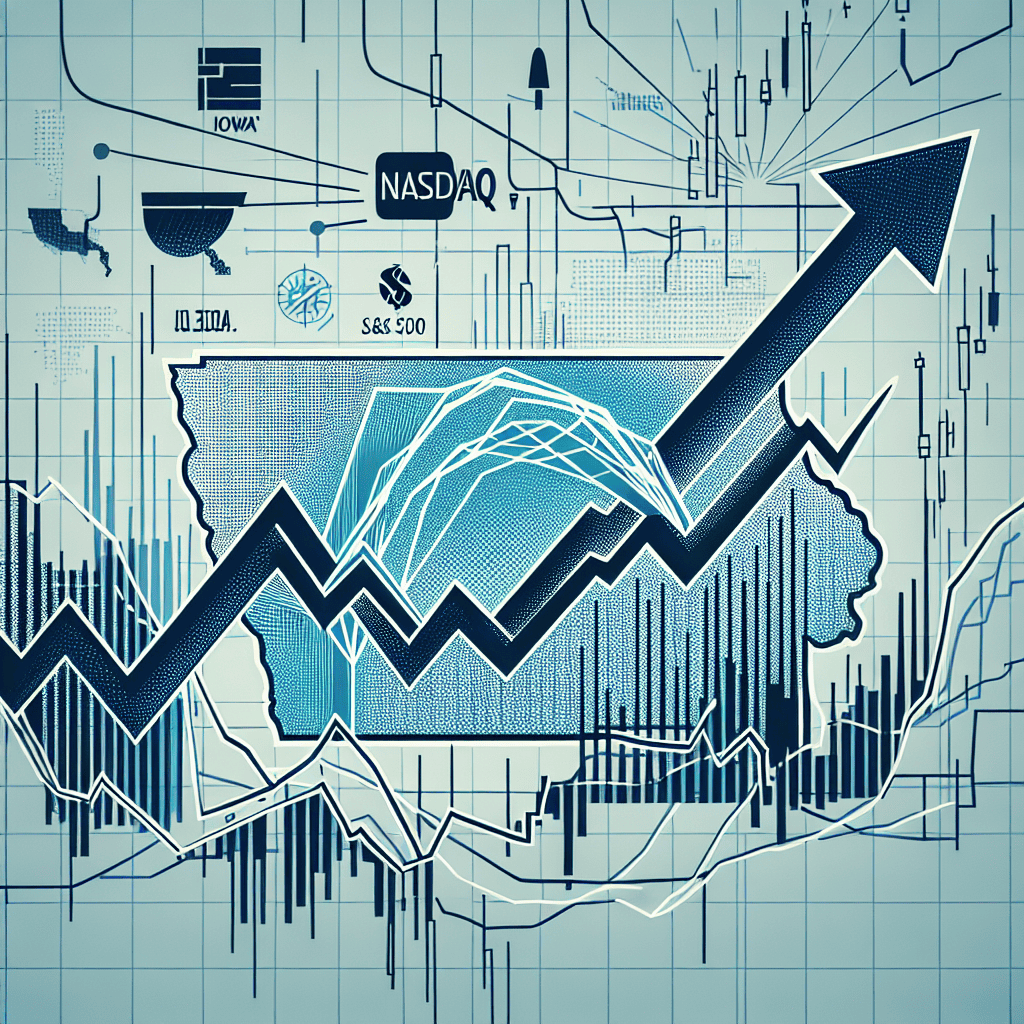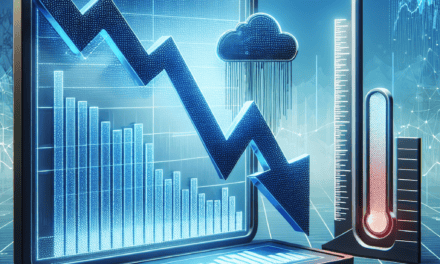“Market Momentum: Nasdaq and S&P 500 Rise as Iowa Shakes Up Trump Trade Dynamics”
Introduction
The stock market witnessed a notable shift as the Nasdaq and S&P 500 indices experienced upward momentum, driven by developments related to Iowa’s influence on the Trump trade policies. This movement in the market reflects investor sentiment and reactions to political and economic factors emanating from Iowa, which have implications for trade strategies associated with the Trump administration. As traders and analysts assess the potential impacts of these developments, the indices’ performance highlights the intricate relationship between political events and market dynamics.
Impact Of Iowa’s Political Climate On Nasdaq And S&P 500
The stock market has always been a barometer of economic sentiment, reflecting the myriad factors that influence investor confidence and decision-making. Recently, the Nasdaq and S&P 500 have experienced a modest uptick, a movement that can be partially attributed to the evolving political climate in Iowa and its implications for what has been termed the “Trump Trade.” This term refers to the market trends and economic policies associated with former President Donald Trump, which continue to exert influence on the financial markets.
Iowa, often seen as a bellwether state in American politics, has been at the center of recent political developments that have caught the attention of investors. The state’s political climate can significantly impact national policy directions, especially during election cycles. As such, any shifts in Iowa’s political landscape are closely monitored by market participants who are keen to anticipate changes in economic policy that could affect corporate earnings and market valuations.
The recent political developments in Iowa have led to speculation about potential shifts in trade policies and regulatory frameworks. Investors are particularly sensitive to these changes, as they can have far-reaching implications for sectors such as technology, healthcare, and manufacturing, which are heavily represented in the Nasdaq and S&P 500 indices. The anticipation of policy shifts has led to a cautious optimism among investors, contributing to the recent gains in these indices.
Moreover, the impact of Iowa’s political climate on the stock market is not limited to domestic policies. International trade relations, which were a significant focus during Trump’s presidency, remain a critical concern for investors. The possibility of changes in trade agreements or tariffs can influence the global supply chain and affect the profitability of multinational corporations. As Iowa’s political climate evolves, investors are keenly aware of how these changes might alter the landscape of international trade, thereby impacting the performance of companies listed on the Nasdaq and S&P 500.
In addition to trade policies, regulatory changes are another area where Iowa’s political climate could have an impact. The technology sector, which is a major component of the Nasdaq, is particularly sensitive to regulatory shifts. Any indication of increased regulation or antitrust actions can lead to volatility in tech stocks. Conversely, a more business-friendly regulatory environment could bolster investor confidence and drive stock prices higher. As such, the political developments in Iowa are being closely watched for any signs of regulatory changes that could affect the tech industry.
Furthermore, the healthcare sector, which is well-represented in the S&P 500, is also influenced by political developments. Changes in healthcare policy, such as those related to drug pricing or insurance coverage, can have significant implications for healthcare companies’ revenues and profitability. Investors are therefore attuned to any political signals from Iowa that might suggest shifts in healthcare policy.
In conclusion, the recent gains in the Nasdaq and S&P 500 can be attributed, in part, to the evolving political climate in Iowa and its potential impact on the Trump Trade. As investors navigate the complexities of political developments and their implications for economic policy, the stock market will continue to reflect these dynamics. The interplay between politics and market performance underscores the importance of staying informed about political trends and their potential effects on the financial markets. As such, investors will be closely monitoring Iowa’s political landscape for further developments that could influence market sentiment and drive future stock market movements.
Analyzing The Trump Trade: How Iowa Influences Market Trends
In recent weeks, the stock market has experienced a series of fluctuations, with the Nasdaq and S&P 500 indices showing a modest upward trend. This movement can be attributed to a variety of factors, one of which is the political climate surrounding former President Donald Trump, particularly the developments in Iowa. The so-called “Trump Trade,” a term used to describe market trends influenced by Trump’s policies and political activities, has once again come into focus as investors assess the implications of his influence on the economy.
To understand the current market dynamics, it is essential to consider the broader context of Trump’s political activities and their impact on investor sentiment. Iowa, a state with significant political clout due to its early caucus in the presidential primary season, has recently been a focal point for Trump’s political maneuvers. His rallies and endorsements in the state have reignited discussions about his potential influence on future elections and, by extension, on economic policies that could affect the stock market.
The Nasdaq and S&P 500 indices have shown resilience amid these developments, edging up as investors weigh the potential outcomes of Trump’s continued political engagement. This upward movement can be partially attributed to the anticipation of policy shifts that could favor certain sectors, such as energy, infrastructure, and manufacturing, which were focal points during Trump’s presidency. Investors are keenly aware that any indication of a return to policies that prioritize deregulation and tax cuts could stimulate growth in these areas, thereby boosting market performance.
Moreover, the market’s response to Iowa’s impact on the Trump Trade is not solely based on political speculation. Economic indicators, such as employment rates, consumer spending, and corporate earnings, continue to play a crucial role in shaping investor decisions. The recent positive economic data has provided a foundation for the market’s upward trajectory, as it suggests a robust economic recovery that could withstand potential political upheavals.
In addition to domestic factors, global economic conditions also influence the market’s response to the Trump Trade. The interconnectedness of global markets means that any significant policy changes in the United States could have ripple effects worldwide. Investors are therefore closely monitoring international developments, such as trade negotiations and geopolitical tensions, which could either amplify or mitigate the impact of Trump’s political activities on the stock market.
As the situation in Iowa unfolds, it is important for investors to remain vigilant and consider both the short-term and long-term implications of the Trump Trade. While the current market trends suggest a degree of optimism, it is crucial to recognize that political landscapes are inherently unpredictable. The potential for sudden shifts in policy or unexpected political developments could lead to increased volatility in the stock market.
In conclusion, the recent upward movement of the Nasdaq and S&P 500 indices amid Iowa’s impact on the Trump Trade highlights the complex interplay between politics and market trends. Investors must navigate this landscape with a keen understanding of both domestic and global factors, as well as the potential for policy changes that could influence economic growth. By staying informed and adaptable, investors can better position themselves to capitalize on opportunities and mitigate risks in an ever-evolving market environment.
Nasdaq And S&P 500: A Closer Look At Recent Gains
In recent trading sessions, the Nasdaq and S&P 500 have experienced modest gains, reflecting a complex interplay of market dynamics and political developments. Investors have been closely monitoring these indices, as they serve as barometers for the broader economic landscape. The recent uptick in these indices can be attributed to a confluence of factors, including corporate earnings reports, economic data releases, and geopolitical events. However, a particularly intriguing element influencing market sentiment is the political climate, notably the developments in Iowa and their potential impact on what has been termed the “Trump Trade.”
The term “Trump Trade” refers to the market movements that have been associated with the policies and rhetoric of former President Donald Trump. These include expectations of deregulation, tax cuts, and infrastructure spending, which have historically buoyed certain sectors such as financials and industrials. The recent political developments in Iowa, where Trump has maintained a significant influence, have reignited discussions about the potential resurgence of these market themes. As a result, investors are recalibrating their strategies, weighing the prospects of a political landscape that could once again favor the policies associated with the Trump era.
Transitioning to the corporate sphere, earnings season has played a pivotal role in shaping investor sentiment. Several tech giants, which are heavily weighted in the Nasdaq, have reported better-than-expected earnings, providing a boost to the index. These positive earnings reports have not only reinforced confidence in the resilience of the tech sector but have also contributed to the overall upward momentum of the Nasdaq. Meanwhile, the S&P 500, which encompasses a broader range of industries, has also benefited from strong earnings across various sectors, including healthcare and consumer goods. This diversification has helped the index maintain its upward trajectory, even as individual sectors face unique challenges.
In addition to corporate earnings, economic data releases have been instrumental in influencing market movements. Recent data indicating robust consumer spending and a resilient labor market have alleviated some concerns about an economic slowdown. These indicators suggest that the economy remains on a stable footing, providing a supportive backdrop for equity markets. However, it is important to note that inflationary pressures and potential interest rate hikes continue to loom as potential headwinds. Investors are therefore keeping a vigilant eye on forthcoming economic data, as these will likely inform the Federal Reserve’s monetary policy decisions.
Geopolitical events, too, have played a role in shaping market sentiment. Ongoing trade negotiations and international tensions have injected a degree of uncertainty into the markets. However, recent diplomatic efforts and signs of progress in trade talks have provided a measure of reassurance to investors. This has contributed to a more favorable risk environment, encouraging market participants to engage in equity investments.
In conclusion, the recent gains in the Nasdaq and S&P 500 can be attributed to a multifaceted set of factors, including political developments, corporate earnings, economic data, and geopolitical events. As investors navigate this complex landscape, they are tasked with balancing optimism about economic resilience and corporate performance against potential risks such as inflation and geopolitical tensions. The interplay of these elements will continue to shape market dynamics in the coming weeks, as investors remain attuned to both domestic and international developments that could influence the trajectory of these key indices.
Iowa’s Role In Shaping The Stock Market Landscape

In recent weeks, the stock market has experienced a series of fluctuations, with the Nasdaq and S&P 500 indices showing signs of upward momentum. This movement can be attributed, in part, to the political developments in Iowa, which have had a notable impact on what has been termed the “Trump Trade.” As investors closely monitor the political landscape, Iowa’s role in shaping market dynamics has become increasingly significant.
To understand the connection between Iowa and the stock market, it is essential to consider the broader context of the Trump Trade. This term refers to the market trends that emerged following the election of Donald Trump in 2016, characterized by a focus on deregulation, tax cuts, and infrastructure spending. These policies were anticipated to benefit certain sectors, such as financials and industrials, leading to a surge in stock prices. However, as political events unfold, the stability of these trends is subject to change.
Iowa, as the first state to hold caucuses during the presidential election cycle, plays a pivotal role in shaping the political narrative. The outcomes of these caucuses often set the tone for the rest of the election season, influencing investor sentiment and market expectations. In recent developments, Iowa’s political climate has been closely watched, as it provides insights into the potential direction of future policies that could impact the Trump Trade.
The recent uptick in the Nasdaq and S&P 500 indices can be partially attributed to the evolving political landscape in Iowa. As candidates vie for support, their policy proposals are scrutinized by investors seeking to gauge their potential impact on the economy. For instance, discussions around trade policies, healthcare reform, and environmental regulations are of particular interest, as they have direct implications for various sectors of the market.
Moreover, Iowa’s agricultural economy adds another layer of complexity to the stock market’s response. The state’s significant role in agriculture means that any changes in trade policies, especially those related to tariffs and international agreements, can have a ripple effect on the market. Investors are keenly aware of how these policies might affect agricultural exports and, by extension, the broader economic landscape.
In addition to political factors, economic indicators from Iowa also contribute to shaping market expectations. Data on employment, consumer spending, and business investments provide valuable insights into the state’s economic health, which can influence national economic forecasts. As such, positive economic signals from Iowa can bolster investor confidence, leading to upward movements in stock indices.
While the Nasdaq and S&P 500 have shown resilience amid these developments, it is important to note that the stock market remains inherently volatile. External factors, such as global economic conditions and geopolitical tensions, continue to pose risks that could offset gains made from domestic political developments. Therefore, investors are advised to remain vigilant and consider a diversified approach to mitigate potential risks.
In conclusion, Iowa’s role in shaping the stock market landscape is multifaceted, encompassing political, economic, and sector-specific factors. As the state continues to influence the national political discourse, its impact on the Trump Trade and broader market trends will likely persist. Investors and analysts alike will continue to monitor Iowa’s developments closely, recognizing its significance in the ever-evolving financial landscape.
The Trump Trade: Understanding Its Effect On Nasdaq And S&P 500
The stock market has always been a complex and dynamic entity, influenced by a myriad of factors ranging from economic indicators to geopolitical events. Recently, the Nasdaq and S&P 500 have experienced a slight upward movement, a development that has captured the attention of investors and analysts alike. This uptick can be partially attributed to the so-called “Trump Trade,” a phenomenon that has been a significant driver of market behavior since Donald Trump’s presidency. The Trump Trade refers to the market’s reaction to policies and political developments associated with Trump, which often emphasize deregulation, tax cuts, and infrastructure spending. These policies have historically been perceived as favorable to business growth and economic expansion, thus impacting major indices like the Nasdaq and S&P 500.
In the current context, the political landscape in Iowa has played a pivotal role in shaping the Trump Trade’s influence on the stock market. Iowa, known for its early caucuses, often sets the tone for political momentum in the United States. As political developments unfold in Iowa, they can signal broader national trends, particularly in relation to Trump’s political fortunes. Investors keenly observe these developments, as they can have implications for future policy directions and economic strategies. The recent political activities in Iowa have suggested a potential strengthening of Trump’s influence, which in turn has bolstered investor confidence in the continuation of business-friendly policies.
Moreover, the Nasdaq and S&P 500’s recent performance can also be linked to broader economic indicators that align with the Trump Trade’s principles. For instance, positive employment data and robust corporate earnings reports have reinforced the perception of a resilient economy. These factors, coupled with the anticipation of continued deregulation and tax incentives, have created an environment conducive to market growth. As a result, technology stocks, which are heavily represented in the Nasdaq, have seen particular gains. The tech sector’s performance is often viewed as a barometer for innovation and future economic potential, making it a focal point for investors looking to capitalize on the Trump Trade.
Transitioning to the S&P 500, this index, which encompasses a broader range of industries, has also benefited from the current market sentiment. The S&P 500’s composition includes sectors such as financials, healthcare, and consumer goods, all of which stand to gain from policies that promote economic expansion and consumer spending. The financial sector, in particular, has been buoyed by expectations of deregulation, which could enhance profitability and growth prospects. Similarly, consumer confidence, bolstered by favorable economic conditions, has driven demand for consumer goods, further supporting the S&P 500’s upward trajectory.
In conclusion, the recent movements in the Nasdaq and S&P 500 can be attributed to a confluence of factors, with the Trump Trade playing a central role. The political developments in Iowa have underscored Trump’s enduring influence, which has, in turn, shaped investor expectations and market dynamics. As the market continues to navigate these complex influences, the interplay between political events and economic indicators will remain a critical area of focus for investors seeking to understand and capitalize on the evolving landscape. The Nasdaq and S&P 500’s performance serves as a testament to the intricate relationship between politics and market behavior, highlighting the importance of staying informed and adaptable in an ever-changing financial environment.
Market Reactions: Nasdaq And S&P 500’s Response To Iowa Developments
In recent trading sessions, the Nasdaq and S&P 500 have experienced modest gains, reflecting a nuanced response to political developments in Iowa that have implications for the broader market, particularly the so-called “Trump trade.” Investors are closely monitoring these developments, as they could signal shifts in policy and economic direction that may affect market dynamics. The political landscape in Iowa has become a focal point, with its potential to influence national sentiment and, consequently, market behavior.
The “Trump trade,” a term that gained prominence following the 2016 U.S. presidential election, refers to the market trends driven by expectations of pro-business policies, deregulation, and tax reforms under the Trump administration. These expectations initially fueled a rally in sectors such as financials, industrials, and energy. However, as political winds shift, so too do the fortunes of these sectors. The recent developments in Iowa, therefore, serve as a barometer for investors gauging the sustainability of these trends.
As the Nasdaq and S&P 500 edge up, it is essential to consider the underlying factors contributing to this movement. The technology-heavy Nasdaq has benefited from robust earnings reports from key players, which have bolstered investor confidence. Companies in the tech sector continue to demonstrate resilience and adaptability, even amid political uncertainties. This resilience is a testament to the sector’s ability to innovate and capitalize on emerging opportunities, thereby maintaining its appeal to investors.
Meanwhile, the S&P 500’s gains can be attributed to a broader market optimism that extends beyond the tech sector. The index, which encompasses a diverse range of industries, reflects a more comprehensive view of the market’s health. Recent economic data, including employment figures and consumer spending, have painted a picture of a resilient economy, further supporting the index’s upward trajectory. This positive economic backdrop provides a cushion against potential political volatility, allowing investors to remain cautiously optimistic.
However, it is crucial to acknowledge the potential risks that accompany these developments. Political uncertainty, particularly in a key state like Iowa, can lead to market volatility as investors reassess their positions based on new information. The interplay between politics and markets is complex, and while the current response has been positive, it is subject to change as new developments unfold. Investors must remain vigilant, keeping a close eye on both domestic and international factors that could influence market sentiment.
In conclusion, the recent gains in the Nasdaq and S&P 500 highlight the market’s nuanced response to political developments in Iowa and their implications for the “Trump trade.” While the technology sector continues to drive the Nasdaq’s performance, the S&P 500’s broader gains reflect a resilient economy that provides a buffer against political uncertainties. As investors navigate this landscape, they must balance optimism with caution, recognizing the potential for volatility amid shifting political dynamics. The market’s response to Iowa serves as a reminder of the intricate relationship between politics and economics, underscoring the importance of staying informed and adaptable in an ever-evolving environment.
Strategic Insights: Navigating The Stock Market Amid Political Changes
In recent weeks, the stock market has experienced a series of fluctuations, with the Nasdaq and S&P 500 indices showing a modest upward trend. This movement comes amid a backdrop of political developments, particularly the unfolding events in Iowa, which have had a notable impact on what has been termed the “Trump Trade.” As investors navigate these changes, it is crucial to understand the interplay between political dynamics and market performance.
The term “Trump Trade” refers to the market trends and investment strategies that emerged following the election of Donald Trump in 2016. These trends were characterized by a focus on deregulation, tax cuts, and infrastructure spending, which collectively spurred optimism among investors and led to a significant rally in the stock market. However, as political landscapes shift, so too do the factors influencing market behavior. The recent developments in Iowa, a state with considerable political significance, have introduced new variables into the equation.
Iowa’s impact on the Trump Trade is multifaceted. On one hand, the state’s political climate can serve as a bellwether for national sentiment, particularly in the context of presidential elections. As such, any shifts in voter preferences or political alignments in Iowa can have ripple effects across the broader market. On the other hand, Iowa’s economic contributions, particularly in agriculture and renewable energy, play a role in shaping investor expectations and strategies. The state’s policies and political leanings can influence sectors that are integral to the Trump Trade, thereby affecting market performance.
In light of these developments, the Nasdaq and S&P 500 have shown resilience, edging up as investors assess the implications of Iowa’s political landscape. This upward movement can be attributed to several factors. Firstly, the technology sector, which is heavily represented in the Nasdaq, continues to demonstrate robust growth. Companies within this sector have shown adaptability and innovation, which have bolstered investor confidence despite political uncertainties. Additionally, the S&P 500, with its diverse range of industries, benefits from a balanced approach that mitigates risks associated with political volatility.
Moreover, the Federal Reserve’s monetary policy plays a crucial role in shaping market dynamics. With interest rates remaining relatively low, borrowing costs are minimized, encouraging investment and spending. This environment supports the upward trajectory of the stock market, even as political factors introduce potential challenges. Furthermore, the global economic landscape, characterized by ongoing recovery efforts from the pandemic, provides additional context for understanding market movements. International trade relations, supply chain disruptions, and geopolitical tensions are all elements that investors must consider when evaluating the impact of political changes on the stock market.
As investors seek to navigate these complexities, strategic insights become invaluable. Diversification remains a key strategy, allowing investors to spread risk across various sectors and asset classes. Additionally, staying informed about political developments and their potential market implications is essential for making informed investment decisions. By understanding the interconnectedness of political events and market trends, investors can better position themselves to capitalize on opportunities and mitigate risks.
In conclusion, the recent upward movement of the Nasdaq and S&P 500 amid Iowa’s impact on the Trump Trade underscores the intricate relationship between politics and the stock market. As political landscapes continue to evolve, investors must remain vigilant and adaptable, leveraging strategic insights to navigate the ever-changing market environment. Through careful analysis and informed decision-making, investors can successfully manage the challenges and opportunities presented by political changes.
Q&A
1. **Question:** What recent event has influenced the stock market, particularly the Nasdaq and S&P 500?
– **Answer:** The Iowa caucuses have impacted the stock market, influencing the Nasdaq and S&P 500.
2. **Question:** How did the Nasdaq perform in response to the Iowa caucuses?
– **Answer:** The Nasdaq edged up following the Iowa caucuses.
3. **Question:** What was the performance of the S&P 500 in the wake of the Iowa caucuses?
– **Answer:** The S&P 500 also edged up amid the impact of the Iowa caucuses.
4. **Question:** What is the “Trump Trade” in the context of the stock market?
– **Answer:** The “Trump Trade” refers to market movements and investor strategies influenced by policies and political developments associated with former President Donald Trump.
5. **Question:** How did the Iowa caucuses specifically impact the “Trump Trade”?
– **Answer:** The Iowa caucuses affected investor sentiment and strategies related to the “Trump Trade,” contributing to movements in the Nasdaq and S&P 500.
6. **Question:** What sectors or stocks were most affected by the Iowa caucuses?
– **Answer:** The specific sectors or stocks affected can vary, but typically those sensitive to political developments, such as healthcare, technology, or financials, might see notable impacts.
7. **Question:** What are investors likely considering in response to the Iowa caucuses’ impact on the market?
– **Answer:** Investors are likely considering the implications of political outcomes on economic policies, regulatory changes, and market stability.
Conclusion
The stock market saw a positive movement with both the Nasdaq and S&P 500 indices edging up, influenced by developments related to Iowa’s impact on the Trump trade. This suggests that investor sentiment was buoyed by political factors, possibly reflecting optimism about policy outcomes or economic implications tied to the Trump administration’s influence. The market’s response indicates a cautious yet positive outlook, as traders and investors adjust their strategies based on the evolving political landscape and its potential effects on trade and economic policies.





